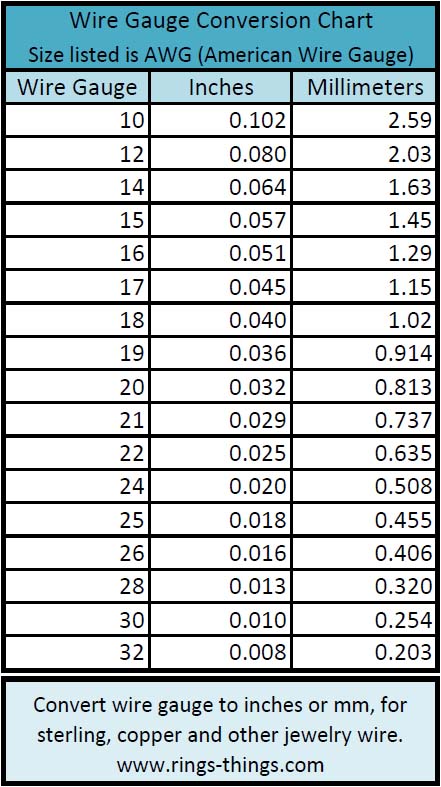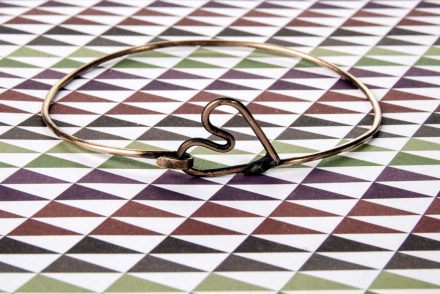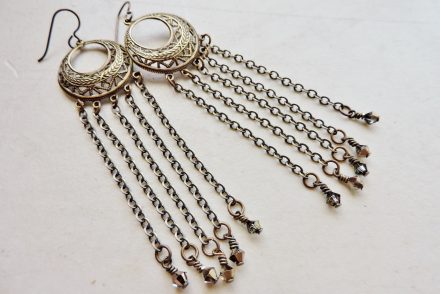Wire Gauge Chart
Gauge is often abbreviated “ga” or simply “g”. If you can’t find what you’re looking for when searching a website, you may need to try the following variations: 28-gauge, 24ga, 22g, 20 gauge, and/or 18 ga to find what you want.
The most important thing to know about wire gauge is:
LARGER wire gauge NUMBERS = SMALLER/THINNER wire.
- 30 gauge wire is very thin, excellent for wire stitching and fine wire weaving.
- 21 gauge is a a popular size for ear wires in the United States (some other countries have thicker ear wires). To make nice ear wires that don’t bend out of shape, many people buy 18 gauge or 20 gauge dead-soft sterling silver wire and pull it through a draw plate to size it down, while the draw plate both work-hardens the wire, and makes it springy.
- 10 gauge is very heavy. It is likely to break inexpensive jewelry pliers, and dent or break most wire cutters. (Use a jeweler’s saw to cut heavy gauges of wire.)

Wire Gauge Conversion Chart (AWG)
Picking the right size hole punch or drill bit for your wire gauge:
When punching a hole for a jump ring, you normally want a hole at least twice the diameter of your wire. This allows for good freedom of movement.
When riveting, either measure and drill a hole the exact right size, or punch a hole slightly too small, and then enlarge it to the perfect size with a bead reamer (or round file). Riveting with a hole that is too large, can cause your rivet to bend or slip, both of which can cause additional problems. More info @ Riveting 101 (for jewelry and small mixed media artworks).
- 1/16″ hole punch = .0625 inches or 1.59mm (a tiny bit smaller than 14 gauge) – so a 1/16″ hole, plus a few turns of a bead reamer, is perfect for riveting 14ga wire.
- 3/32″ hole punch = .0938 inches, or 2.38mm (roughly 11 gauge)
- 1/8″ hole punch = .125 inches, 3.18mm
- The new 3-hole punch by Eugenia Chan punches 1/8″, 3/32″ and 1/16″ that correspond with standard tube rivets (aka eyelets): 1.6mm, 2.4mm, and 3.2mm.
- The new 4-hole punch by Eugenia Chan punches holes that are the exact correct size for 18-gauge, 16-gauge, 14-gauge and 12-gauge wire rivet holes.
OH GOSH DARN IT! I accidentally made this live before I finished it…
Still to Add:
- bracelet sizes from old catalog page 777?
- typical # of round beads per strand
More helpful links:
- Standard (and not-so-standard) Jewelry Units of Measure (gross, mass, etc.).
- Quick (or exact… your choice) jewelry size conversions between inches and millimeters.





2 Comments
I would love to see this finished, I am revisiting riveting I learned about 8 years ago and cannot seem to find any sterling tubing to match exactly to a drill bit or wire gauge, I really like doing both wire and tube rivets and have drill bits for my various gauges of wire. I want tubing in sterling, copper and brass, any ideas?
thanks
Della
Hi Della,
We do have tubing in copper and brass, and some helpful info about what size tubing holds what size wire at the top of this page: http://www.rings-things.com/Products/Base-Metal-Tubing/
And, we have sterling tubing too: http://www.rings-things.com/Products/Sterling-Silver-Metal-Tubing/ If you click into the sterling “Watch Band” tubing’s details, it says it can be used for 14g wire.
In the “Learn” tab on our main website, we have our Riveting 101 page which includes a link to a PDF I made many years ago (so there are newer, cooler tools available now), that explains a lot about the basics of drilling and enlarging holes for tubing and wire: http://rings-things.com/Designer%20Tip%20Sheets/Techniques%20for%20Riveting.pdf
And yeesh, I still haven’t finished this blog article! Thank you for the questions and reminder.